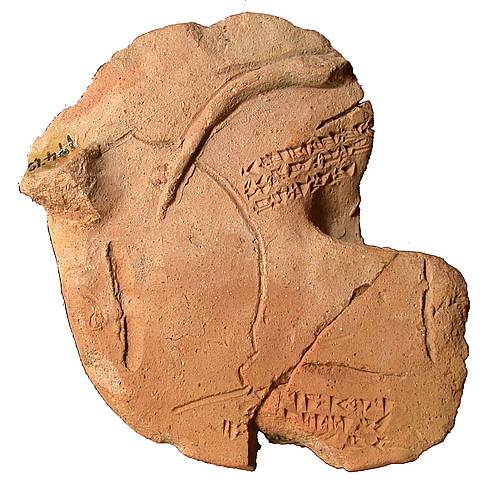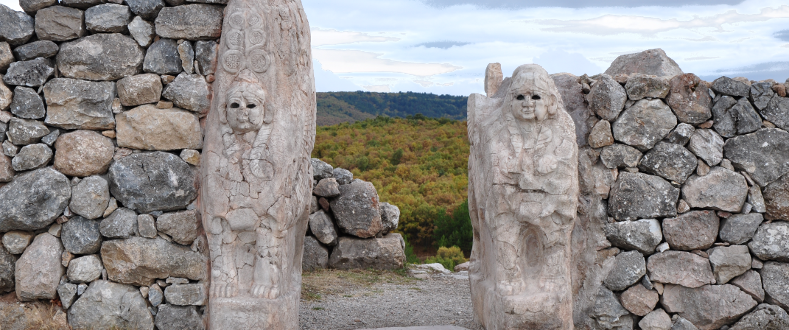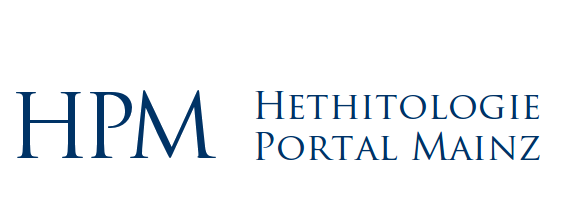Oracles and Omens: Hittite Divination
Since antiquity, both oracles and divination have been accompanied by accusations of fraud and superstition. When dealing with the Hittite culture, however, the widespread tendency to undervalue the texts of this genre a priori should not be yielded to. In this case, divination – alongside prayer and the temple cult – forms an elementary part of religious life.
Life in Accord with the Will of the Gods
The following passage from the prayer of Kantuzili, a prominent Hittite priest of the first half of the 14th century, presents the function of divination quite clearly:

“Now may my god open his innermost soul to me with all his heart, and may he tell me my sins so that I can acknowledge them. May my god either speak to me in a dream — and may my god open his heart and tell me my sins so that I can acknowledge them — or let a dream interpretess speak to me or let a diviner of the Sun-god speak to me by reading from a liver in extispicy, and may my god open to me with all his heart his innermost soul, and may he tell me my sins so that I can acknowledge them.”
In his suffering, apparently forsaken by the deity invoked, the supplicant searches for possible causes of the deity’s anger: his own deeds or omissions which are contradictory to the will of the gods. The deity’s answer to the prayer, though, can be acquired by the methods of divination. The reference to a mantic diagnosis in what was one of the most politically volatile prayers of Hittite literature demonstrates that the confirmation of such a transgression by means of a divine oracle was not taken lightly. The gods had been angered by the murder of Tudhaliya, through whose death Suppiluliuma, the father of Mursili, had taken up the office of the Hittite king:
“And since for twenty years now in Hatti people have been dying, the affair of Tudhaliya the Younger … started to weigh on me. I enquired about it to the god through an oracle, and the affair of Tudhaliya the younger was also confirmed by the deity.”
Systematic Investigation of the Divine Will
If the conditions or transgressions which caused the anger of a deity were to be identified through an oracle, then this necessitated unambiguous and concrete answers from the enquired deity. In order to attain precisely such results, the Hittites developed a clever oracular method; although individual elements thereof were borrowed from Babylonia and the Hurrians, in its system it was unique in the ancient Near Eastern world.
The foundational principle followed a binary scheme. In addition to the (often detailed) enquiry, the seer also included with it a hypothetical result. This was oriented according to the favourable or unfavourable character of the conditions described in the enquiry: “When such and such behaves so and so, then the oracle enquiry shall be unfavourable (or favourable)!” If the actual findings of the performed oracle coincide with this hypothetical result, then the hypothetical circumstances also formulated in the enquiry are confirmed by divine authority.
This simple core scheme is then expanded upon in two respects: For one, numerous enquiries which are logically based upon one another are made sequentially; step by step an increasingly exact result is attained. Second, the Hittites were familiar with more than one oracular technique; the accuracy of a finding achieved by one particular technique can therefore be tested by means of an alternative method. As a result, a complicated oracular system developed which guaranteed the highest degree of precision and reliability.
Hepatoscopy: Babylonian Tradition in Hattusa
In the 3rd millennium BC, it was already common in Babylonia to examine the entrails of an animal offering, especially of sheep as a typical offering, for ominous findings. The condition of the liver was especially observed; but lungs, heart, large intestine, breastbone and vertebrae were also given consideration. The presence and form of at least eleven individual areas and organs which were regarded as parts of the liver were also surveyed, including the gall bladder. The sum of the observed details produced a positive or a negative total result.
Since the 2nd millennium, paradigmatic findings and their results had been collected in large compendia which are referred to in short as “omens”. These omen series as well as the practice of hepatoscopy itself were widespread even outside of Babylonia. The Hittites adapted their knowledge of extispicy from the Hurrians, whose culture had decisively shaped Upper Mesopotamia and northern Syria in the 2nd millennium.
Sheep liver models – some of them with text inscriptions – served as teaching material and points of reference and were known throughout the ancient Near East. Among the Etruscans such liver models and the practice of hepatoscopy are also known – an inheritance from the Near East.
“Then we set about to make oracular enquiries with birds”
Birds are at the centre of another technique of divination: augury – the observation of birds in flight. Like extispicy, augury was known throughout the cultures of the ancient Near East – and once again this inheritance from the Orient lived on among the Greeks and Romans. The origins of this type of augury appear to lie in the regions of Upper Mesopotamia and Syria.
In Anatolia, however, this form of divination was perfected to an unparalleled degree, as the detailed Hittite protocols of augury practices strikingly demonstrate. It is certainly no mere coincidence that Syro-Anatolian influences precisely on this type of mantic practices can also be observed in later Assyria. The Hittite augurs watched the behaviour of wild birds – the texts mention almost thirty different species of birds in this context – within their field of vision for the course of a certain period of time; the motions of the birds were recorded from the point of view of the augur.
An example can be cited from an excerpt of a Hittite letter from the 14th century, which reports the execution of a bird oracle:
“These birds of ‘agitation’ appeared: First, a marassi-bird flew down behind …; then an eagle …; an alliya-bird flew down behind …; he encountered his companion below. … Behind the road: the eagle flew down behind …”
How the result of such observations was found eludes us; but here as well, the oracular enquiry included a hypothetical result which the birds either “established”, that is confirmed, or “rejected”, to use the terms of the texts.
The Wise Woman Enquires the Fate
In addition to extispicists and augurs, the texts also regularly refer to a third specialist of divination, the “Wise Woman” (Sumerian logogram: munusšu.gi “old woman”). Those oracles which the Hittites simply referred to as “action” (Sumerian logogram: KIN) are her specialty. The Wise Woman interprets constellations of diverse symbolic objects, in other words, various lots. At least some of these lots are moveable, and can “act” to a certain degree. We do not know how the Wise Woman caused these lots to move and what the individual symbols looked like; occasionally the names of the lots refer directly to the subject about which the enquiry is being made, but mostly an established inventory of symbols is employed.
The protocol of such an oracle, whose enquiry here related to a woman named Sauskatti, appears as follows:
“The king took rightness and laid it to the right of sauskatti. On the second ‘day’: the small illness was taken and it is in the good. On the third ‘day’ the anger of the gods is taken and given to the sun-god of heaven. (Result:) Favourable.”
Another method of divination also used by the Wise Woman and closely related to the lot-oracles employed a snake as a moveable element. The expert observed in which way the snake moved between two symbols.
A Universal Instrument of Explanation
With the help of combinations of diverse oracular techniques serving as counterchecks and long sequences of cleverly coordinated enquiries, it is not only possible to find out the reason for the anger of a particular deity. On the contrary, the oracle becomes a universally applicable and, practically, a scientific-rationally functioning instrument of explanation in itself. Whether with reference to the correct route on a military campaign, the identity and transgressions of enemies of the king, intrigues within the royal court or the correct execution of cultic practices in harmony with the desires of the deity: In important cases of doubt, one turned to the deity by means of an oracular enquiry. The refined system of the oracle also ensured that the Hittite king could never come into the situation of Kroisos, who was misled by an ambiguous oracle.
Nightmare and Solar Eclipse
A typical occasion for an oracular enquiry was a troubling dream since the gods spoke directly to humans by means of dreams. Thus the augury cited in excerpts above was performed in order to explain a dream in which “the daughter … (was) beaten repeatedly”.
In the reverse case, dreams were also actively employed as an oracular technique. Incubation – sleeping in the temple – was the duty of the priests. Unfortunately, the texts offer hardly any information about this form of divination; regrettably, the same is also true for the exercise of prophecy through an ecstatic, the “man of god” (Hittite siuniyant-).
The meaning of unusual natural phenomena, which apparently must have also been understood as the message of a deity, could be established by an oracle as well: Thus for Mursili II an oracle determined that an unusual solar phenomenon – apparently an unfavourable omen – which he observed on his campaign to Azzi did not relate to himself directly. Notably, the astronomical Babylonian omen compendia which were at least partially known in Hattusa were not utilized in this case. Apparently, these were never consistently integrated into the specifically Hittite concept of divination, since the Hittites themselves did not prepare collections of omens according to the Babylonian model.
© Daniel Schwemer
An extensive version of this text appeared as „Leberschau, Losorakel, Vogelflug und Traumgesicht: Formen und Funktionen der Vorzeichendeutung“, in: Die Hethiter – Begleitband zur Ausstellung der Kunsthalle der Bundesrepublik Deutschland, Bonn 2002, 140–45.

